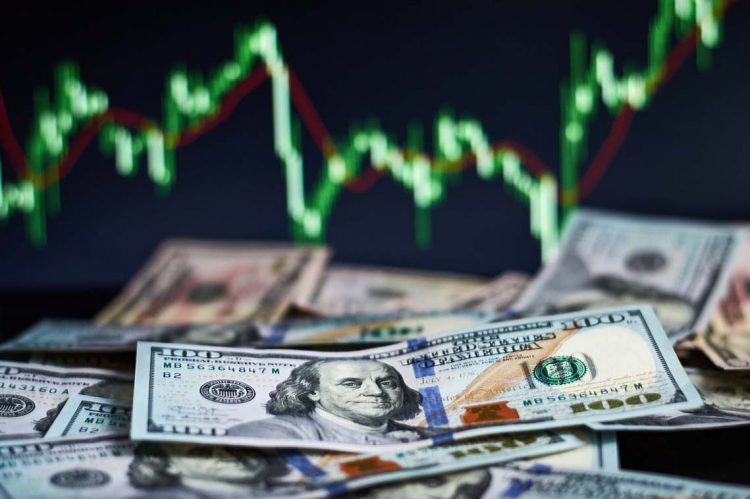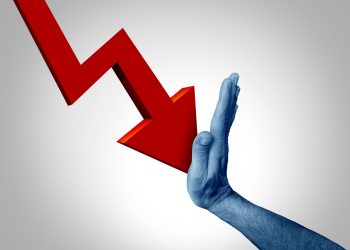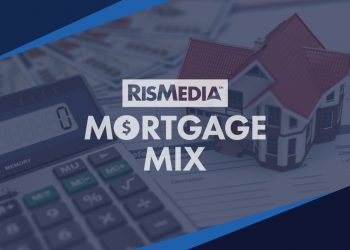Editor’s Note: RISMedia’s Year-End Outlook series provides an in-depth analysis of the housing market’s leading indicators for economic health, and showcases expert insights on what’s to come in 2022.
Inflation is not normal right now—that is something no one is disputing. Core inflation was up 4% year-over-year last month, double what the Federal Reserve has set as a target, and overall inflation hit an alarming 5.4% in September. Essential items like groceries, energy and rent have all spiked, causing concern across broad swaths of the economy.
Though many pundits have disputed the Fed’s assertion that this inflation is “transitory,” economists and other experts who spoke to RISMedia predicted that barring catastrophic, unforeseen new developments or a significant regression in the fight against the pandemic, the current path of inflation will not immediately upend the real estate industry—though inventory issues make take some time to resolve and broader policy shifts could have long-term ramifications for housing.
“I expect demand to remain strong,” says Nadia Evangelou, senior economist for the National Association of REALTORS® (NAR). “We expect to be at normal levels .”
Amid a world-wide supply chain crunch and a historically hot housing market, the sharp rise in inflation is actually not even one of the biggest concerns for real estate professionals going forward. Delays in building new homes—something only partially attributable to inflation and the supply chain—is likely to have a larger impact and last longer, the economists say, even if the Fed misses its goal of 2% inflation by the middle of next year.
Fed Chair Jerome Powell has indicated that the central bank will begin tapering its bond purchases starting as early as this year and could start raising interest rates if inflation remains at a concerning level, with more clarity expected following the board’s next meeting on Nov. 3.
Matthew Gardner, chief economist for Seattle-based independent brokerage Windermere, says that the top-level data and inflation numbers are actually not offering an appropriate, contextual picture of what is going on. He adds that rather than looking at year-over-year numbers, using an annualized comparison to February of 2020—before the onset of the pandemic—can give a more accurate reading of current inflation concerns.
“It is kind of silly to look at year-over-year comparisons because they’re not informative. And they’re not informative because, look at where we were last year,” he says. “If you go back to February of last year, the compounded annual growth rate is not 4%, it’s 3%.”
“So that’s better, but it’s still not good,” he admits.
If you subtract one of the most extreme outliers in price increases—namely used cars which have risen close to 30%—you can get the inflation rate down to about 2.2%.
“Really not terrible,” he says.
This angle might help reassure people who are worried that the country is on track for any kind of runaway hyper-inflation. But there are still many questions and uncertainties that will need to be resolved in the months ahead.
Jeff Cohen is an economist and professor at the University of Connecticut. He says he is less convinced that inflation will simply return to the extremely stable pattern it has held over the last decade even once supply chain and pandemic disruptions are resolved—something that optimistically could happen by the end of next year.
“That doesn’t mean it’s going to be gone forever,” he warns.
The Fed’s plan is far from set in stone, Cohen says, and any prediction they have made publicly or any policy that is implemented could easily be dropped depending on the month-to-month progress of the economy and the pandemic.
One of his biggest concerns is the rising cost of rentals, Cohen says, which he predicts will either continue their sharp increases seen over the last couple months or at best, flatten out. Pressure on the rental markets caused by competition and the market power of institutional investors will not be solved without policy shifts and big investments in affordable housing, according to Cohen.
“I don’t see them going down in the near future, just because there is a national shortage of affordable housing,” he says.
From a broader numbers standpoint, Gardner says he is slightly less optimistic about inflation compared to the Fed’s broad predictions (he advises the Philadelphia branch of the bank), predicting that core inflation will peak around 5% in the first quarter of next year and not reach the target of 2% or 2.5% until the end of 2022. This is not likely to deeply affect the real estate market, though, as even a moderate increase in interest rates will fail to dampen demand for homes.
The resilience of the real estate market against even significant inflationary growth can be attributed both to the fundamental principle that real estate investment is a hedge against inflation, Gardner says, along with the particular (and unprecedented) current market conditions.
Brooke Dalzell is the vice president of Minute Mortgage in Arizona. She says inflation does not so far seem to be influencing people one way or another and the demand for mortgages remains red-hot.
The anticipation that the Fed will begin tapering bond purchases and increasing interest rates is also not causing any significant alarm among consumers, with refinances down but new mortgages holding steady.
“From a purchase standpoint, I would say we are relatively stable,” she says. “People may see inflation rise so they may cut down on spending, but as far as mortgages—the only real relationship we see is between inflation and interest rates.”
The Mortgage Bankers Association has predicted that the 30-year fixed mortgage rate will hit 4% by the end of 2022 based on strong economic growth and the Fed’s plans. Dalzell says that no one can know for certain exactly where the rate will fall, but even significant increases likely will not fully stymie demand for homes.
“I think the real question will be how long will inflation stay where it’s at,” she says.
Evangelou says she believes part of the reason demand will slow but not falter despite the effects of inflation is the current demographic of homebuyers, who are both inelastic and zealous in their desire for homes.
“Millenials are the largest cohort of homebuyers…they have all these lifestyle needs,” she says.
Even in the incredibly competitive (and often over-priced) market for buyers, millennials were still buying homes, according to Evangelou, and will remain eager to do so regardless of things like mortgage rate and the price of gas and cars—at least within reason.
Matt Cohen is a real estate agent for Brown Harris Stevens, focused mostly on the luxury market in New York City. He says that in his market, many upper-middle-class families have been saving money and remain eager to flex their buying power as other luxury goods remain scarce.
“They can’t spend money because things are sold out, or it’s going to take a year for it to come back, or furniture is eight months delayed,” he says. “The one thing that people can do even if there is low inventory is buy real estate.”
Though the New York City luxury market might differ from much of the country, from that perspective of consumer confidence, Gardner agrees that inflation is unlikely to dissuade too many potential homebuyers.
“Rising inflation is unlikely to offset demand given the expectation that mortgage rates are going to rise, and people just want to lock in that historically low rate if they haven’t already. The impacts are going to be felt in the new construction arena because of price,” he says.
Construction and Hyperinflation
If Fed policy and pandemic recovery is successful at calming the rate of inflation, that does not necessarily mean some of the pains that real estate is going through will be alleviated. The underlying cause—pandemic disruptions and specifically, a global supply chain meltdown—are not going to be solved on Wall Street or by the Fed.
Some people have worried that the economy is on track for a scenario like what was seen in the late 1970s and early 80s, where the country reached double-digit “hyperinflation” sparked by an oil crisis and wartime spending. According to Gardner, the current situation is essentially nothing like that one.
“There’s all manner of things that are different,” he says. “People see this and think we’re going back there again, and we’re not.”
A large portion of the products, components and commodities that are squeezing prices higher have relatively short-term fixes, Gardner says. Either through corrections to the supply chain issues, or as other pandemic-related disruptions normalize, everything from computer chips to vegetables will start reaching stores or factories in (relatively) short order. This is in contrast to the late 1970s when the United States was heavily dependent on foreign oil and took a very different approach at the policy level.
At the same time, Gardner says supply-chain issues are not going to be solved overnight, and even when they are, it might not immediately bring housing inventory to a level that can meet demand, which has been the most persistent problem of the last year or so for real estate.
Labor shortages, regulatory fees, land costs and risk management are all going to hamper attempts by builders to put up enough homes to meet demand, according to Gardner, even if the price of lumber and other construction materials normalize.
“There’s certainly a lot of impediments,” he says.
The U.S. is at least 200,000 workers short in the home-building industry, he says. At the same time, a little-known census metric that measures the number of homes currently under construction (separate from “housing starts,” which have been down nearly the entire pandemic) is actually on the rise, which Gardner says could indicate the industry is maybe more on track to catch up in inventory.
“So there’s a lot of different nuances to it. But simply speaking we’re still not building enough to meet demographically driven demand,” he admits. “I think there’s still a lot of pent-up demand that is still waiting on the sidelines.”
Cohen says a recent drop in lumber prices can be seen as a “bright spot,” but warns that another very unpredictable and volatile metric on the rise—fuel costs—could quickly tighten pressure on builders even as other burdens are lifted. He also warns that acquiring land in certain markets, particularly in the west and northeast where the cost of land has always been extremely high and relatively inelastic, will prevent those areas from meeting demand—at least with traditional single-family homes.
Likely builders will begin replacing traditional starter homes with multi-unit townhouses, condos or cluster developments, Cohen posits, which many local governments have facilitated by relaxing zoning restrictions. This is already happening in New England and can definitely help alleviate the housing crisis, he promises, but also creates problems of its own.
“So that might be one way to resolve the supply issue in some ways, but not for the people who are looking for the starter home,” he says. “You can’t get into a bidding war like that , where the house is worth $500,000 but someone is offering $1.1 million because they’re just going to use the land to build a tremendous amount of units and then sell each one for $500,000.”
Another new practice that is becoming more common due to supply shortages is people buying homes that have yet to be constructed—sometimes that haven’t even begun construction. Dalzell says she has seen that scenario become much more common in her market in Arizona, and Gardner says rising inflation—even short-lived inflation—could quickly create chaos for people involved in those transactions.
“If my costs go up , I’m going to pass that directly on to you,” Gardner says. “I don’t know anyone that will want to buy a home when he’s not sure what the price is going to be.”
 Jesse Williams is RISMedia’s associate online editor. Email him your real estate news ideas to jwilliams@rismedia.com.
Jesse Williams is RISMedia’s associate online editor. Email him your real estate news ideas to jwilliams@rismedia.com.












